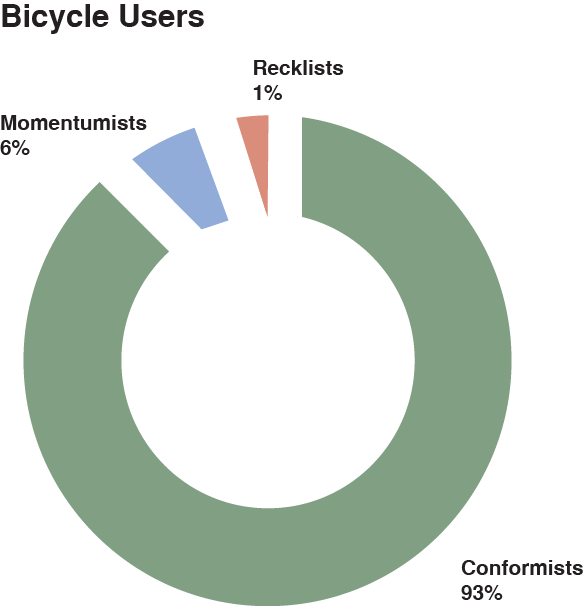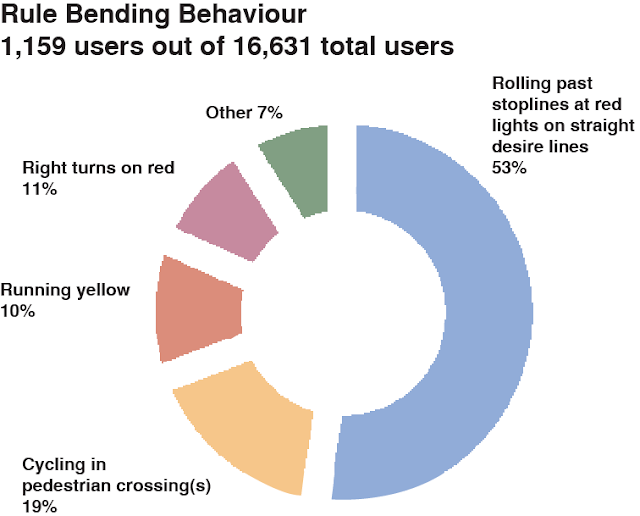

As I highlight in this TED x Zurich talk of mine about Bicycle Culture by Design, Copenhagen has the world’s best behaved cyclists. Bar none. I’ve cycled in close to 100 cities around the world and I’ve never seen anything that comes close. Citizens in any city do not - contrary to popular perception - wander around all day looking for laws to break.
Wherever you happen to be reading this from, you’re probably aware of the general perception of “those damned cyclists”. Even here in Copenhagen, the perception persists, not least from the Copenhagen Police and their one-man wrecking crew. They - and he - continue to spread personal perceptions about cycling citizens. 52% of the citizens in Copenhagen ride each day and most of the others have bikes that they use regularly. We are dealing with basically the entire population of a European city. The police are out of their league when it comes to behaviour perception.
This perception is as old as the bicycle itself. One of Denmark’s most loved satirists and cartoonists Storm P. (Robert Storm Petersen), a daily bicycle user, highlighted with great Danish irony the silliness of such perceptions in his piece A New Traffic Etiquette for Cyclists - in 1934. Things haven’t changed. The whining minority still whines about the cycling majority. A sign that we need to change the paradigm of planning to prioritise intelligent forms of transport, instead of merely accepting the car-centric status quo that we inherited from a previous century.
Behaviour hasn’t changed for over 100 years - and won’t be changing anytime soon. Here’s my baseline: We can’t very well expect bicycle users to adhere to a traffic culture and traffic rules engineered to serve the automobile, now can we? It is like expecting badminton players to use the rules of squash. Every single moment of every single day, the citizens of our cities are communicating with us. They are sending messages about the urban space they inhabit and it is of utmost importance that we listen to every communication. Unfortunately, planning and engineering are often too self-absorbed and arrogant to answer the calls of the citizens. Desire Lines are democracy in action and democracy in motion. They are, however, more than merely the mobility patterns of our citizens. They are the physical manifestation of much of the communication from our tireless army of urban cartographers. I find them to be quite beautiful. Not to mention incredibly useful, especially in bicycle planning and even in a city like Copenhagen.
If you’ve been reading this blog for awhile, you’ll know all too well our fondness for Desire Lines related to bicycle planning and research. What started with The Choreography of an Urban Intersection has morphed into numerous Desire Lines Analyses of other streets and intersections in Copenhagen and, most recently, Amsterdam. Together with the University of Amsterdam we are analysing behaviour and Desire Lines at ten intersections.
With The Choreography of an Urban Intersection back in 2012, Copenhagenize Design Co. decided to take things to the next level regarding bicycle user behaviour. A study of that size and scope had never been undertaken before. So much commentary about bicycle user behaviour has been based on perception for far too long. “Those damned cyclists” repeated ad nauseum in dozens of languages has made us forget that we don’t actually know very much about their behaviour. In most cities, the reason for what is percieved as “bad behaviour” is simply the fact that bicycle users haven’t been given adequate infrastructure or, even worse, none at all.
The explempary behaviour of Copenhagen bicycle users is due to the fact that the bicycle infrastructure network is, largely, so well-designed. Best Practice has been achieved and, for the most part, it is implemented.
Nevertheless, if you ask certain uniformed civil servants who work for the Copenhagen Police, it is their personal perception that hits the headlines. With The Choreography of an Urban Intersection we decided to get some numbers to show that the perceptions are coloured with emotion and lack data and fact. As the graph at the top indicates, out of 16,631 bicycle users in the intersection Godthåbsvej/Nordre Fasanvej only 1% broke a serious traffic law. Running a red light or riding on the sidewalk. We called them Recklists. The Momentumists were a group that technically broke a Danish traffic law. We put these infractions in a different category. Basically, if it is legal in another city or country with respectable cycling levels, we are okay with it. The rest, the Conformists, did everything by the book.
The results are mirrored by the results in our other studies of other intersections. The vast majority are just playing by the rules.
You can see which rules are being bent in the above graph. What is incredibly important to consider is HOW the rules are being bent. What is the actual behaviour of the individual Momentumists when you study each one with detailed obversation? In short, it is exemplary. It is quite beautiful. One of the primary findings was that when an individual entered a zone where a law was being bent, they were aware of it. The pattern was the same: they would change their physical form.
.png)
Generally, the individual would make themselves appear larger. Rising up from their normal cycling position in order to make themselves more visible to others in the urban theatre. Sometimes this was enough for them but many would also look around with a sweet, apologetic look - vaguely, not at anyone in particular - as though to say “sorry… I know, I know… bear with me”. And when they hit the cycle track again, they would assume their usual cycling position. Some would do the classic bicycle chameleon move, swinging their leg off and using the bicycle as a scooter. Again, always aware of their surroundings and the other users of the urban theatre. This subtle awareness of their surroundings was impressive. At no point in the 12 hours were there “cyclist-pedestrian conflicts” as they’re called in Emerging Bicycle Cities. In that regard, it was like watching paint dry. The flow was constant, smooth and elegant. It was choreography. Even the Recklists were heartwarmingly civilised in their behaviour, showing consideration for others. Only three bicycle users out of the 16,631 we tracked roared through a red light. They were all bike messengers. Do what you want with that.
Momentum is paramount when considering how to plan for bicycles. A smooth flow that eliminates the need to stop and get out of the saddle is the key. Simple measures like the railings and footrests in Copenhagen are a fine example. The Green Wave for cyclists on the main arteries leading to the city are another.
Understanding the basic anthropological transport needs of bicycle users - not to mention pedestrians - is the way to designing liveable streets. Bicycles are not cars and this has been the greatest mistake over the past 50 years in city planning… placing bicycles in the same category as motorised vehicles, both regarding traffic laws and the perception of bicycles as vehicles. We are still struggling to rid ourselves of this flawed categorisation all over the world.
Stopping and starting in a car involves pushing down on a couple of pedals. Effortless. Stopping and starting on a bicycle requires a bit more effort. Once momentum has been achieved, a bicycle user will try to maintain it. The countdown signals in the middle of this article are an example of someone out there understanding the needs of bicycle users.
Children understand the simple necessities of traffic planning. Unfortunately, the geekfest that is traffic engineering has all too often forgotten rationality. Campaigns that try to “improve” behaviour are a waste of money. Simply because the people who think them up haven’t bothered to understand the differences between cyclists and motorists or pedestrians.
Change the paradigm.
Read more about the Choregraphy of an Urban Intersections, including all the findings, here. Or you can download the document as a pdf.





